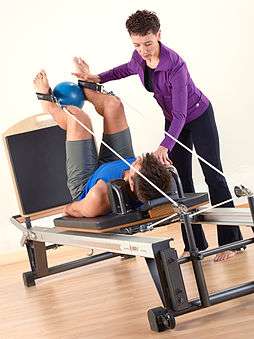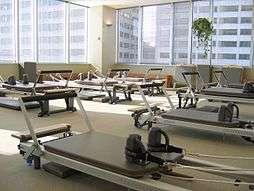Stott Pilates
Stott Pilates is a version[1][2] of the Pilates method of physical exercise. It was developed by Lindsay and Moira Merrithew,[3][4] with the collaboration of physical therapists, and sports medicine and fitness professionals. The most significant difference between Stott Pilates and Joseph Pilates's original method of the early 1900s is that, where the original method uses a straight spine during exercise, Stott Pilates focuses on maintaining the natural curvature of the spine.[5]
History
Following her career as a dancer with the Bermuda Ballet,[6] and principal dancer with the City Ballet of Toronto and the Atlantic Ballet Company,[7] Moira Merrithew learned, with the help of the Dancer Transition Resource Centre,[8] of the Pilates method of exercise. Moira received her Pilates training in New York City from Romana Kryzanowska, a protégé of Joseph Pilates. After her training was complete and her return to Toronto, Moira and Lindsay Merrithew developed the Stott Pilates method in the 1980s. Lindsay has been instrumental in designing, producing and marketing the company's extensive equipment and video lines and is a past member of Ontario's prestigious Innovators Alliance for elite entrepreneurs. Lindsay was nominated twice for Ernst and Young's Entrepreneur of the Year award and is a five-time recipient of PROFIT Magazine's 100 Fastest-Growing Companies award.

Prior to the conclusion, in 2000, of a trademark case[9] about who was entitled to use the word 'Pilates,' The Stott Pilates Method was known as "Stott Conditioning a contemporary approach to the teaching of Joseph H Pilates." In 2010, the company name was changed to Merrithew Health & Fitness, but the name of the method remained Stott Pilates.
Principles
The Stott Pilates method has exercises designed to restore the natural curves of the spine and rebalance the muscles around the joints.[10] The Stott Pilates method places more emphasis on scapular stabilization than other methods. The method focuses on the following five basic principles of breathing, pelvic placement, rib case placement, scapular movement, and head and cervical spine placement.[11]
Training and certification
Stott Pilates trains both instructors and instructor trainers.

They began training trainers in 1990's and have trained trainers from all over the world.[12] The 2000s saw a significant growth in the number of Stott Pilates-trained instructors and, in 2013, there were approximately 38,000 students trained in the method, worldwide.
Certification
For an instructor or instructor trainer to maintain Stott Pilates certification, he or she must attend a minimum number of courses and workshops each year; thereby keeping current with the method.[13][14] Many Stott Pilates courses and workshops are part of the Continuing Education Credit (CEC) programme, and many of them are also recognized by outside organizations, including the American Council on Exercise (ACE).[15]
DVDs
In the mid-1990s, for those without access to a Stott Pilates-trained instructor, and for those who wanted refreshers in the Stott Pilates method, the company started to publish videos[16] and DVDs of most of its programs,[17] and in several languages. Publishing DVDs increased the awareness of the Stott Pilates method as one of the small handful of contemporary versions of Pilates, and was part of what has prompted at least one industry magazine to describe the company as "Industry giant Merrithew Health & Fitness...."[18]
Equipment
Stott Pilates exercises can be done on the floor using a mat or on specialized equipment. Merrithew Health & Fitness manufactures equipment used for Stott Pilates exercises. The main piece of equipment used in the Stott Pilates method is the Reformer, which was designed by Lindsay, a horizontal carriage that glides forward and backward on rollers. Resistance is provided using springs, along with other attachments for a variety of exercises and positions (i.e., lying down, seated, and standing). The mat exercises may also include props such as the Stability Ball, Mini Stability Ball, Toning Balls, Flexband, Fitness Circle, etc..
References
- ↑ Ogle, Marguerite (2010-02-08). "Contemporary Pilates Teachers and Styles". About.com. Retrieved 8 July 2013.
- ↑ Mercer, Lisa. "What is the difference between Pilates and Stott Pilates". LiveStrong.com. Retrieved 10 July 2013.
- ↑ "A Complementary Couple". Pilates Style. Retrieved 14 September 2013.
- ↑ "Founders' Biographies". Merrithew Health Fitness. Retrieved 10 July 2013.
- ↑ Mercer, Lisa. "Stott Pilates and the Spine". LiveStrong.com. Retrieved 10 July 2013.
- ↑ "History". Bermuda Civic Ballet. Retrieved 8 July 2013.
- ↑ "Pilates who's who". Pilates Insight. Retrieved 8 July 2013.
- ↑ 25 Transitions. Dancer Transition Resource Centre. 2011.
- ↑ "Pilates Trademark Case Judgement–Opinion 96 Civ. 43 (MGC)" (PDF). U.S. District Court, Southern District of NY. October 2000. Retrieved 8 July 2013.
- ↑ "Pilates for a healthy back". Spine Institute. The Christ Hospital. Retrieved 10 July 2013.
- ↑ "Stott Pilates Five Basic Principles". Merrithew Health Fitness. Retrieved 10 July 2013.
- ↑ "Stott Pilates Courses". The Central YMCA. Retrieved 10 July 2013.
- ↑ Binnendyk, Christine. "Stott Pilates Certification". LiveStrong.com. Retrieved 10 July 2013.
- ↑ Arnett, Alison. "As millions throng to Pilates classes, questions emerge over certification for teachers". Stretched to the max. The Boston Globe. Retrieved 10 July 2013.
- ↑ "ACE-Approved Providers". Advanced Course Search Results. American Council on Exercise. Retrieved 10 July 2013.
- ↑ Beale, Lucy (2005). The Complete Idiot's Guide to Healthy Weight Loss. New York City: Alpha Books, Penguin Group. p. 354. ISBN 1-4362-9402-9.
- ↑ "Buying a Home Exercise Video or DVD" (PDF). Does the instructor have a good reputation?. Windsor-Essex County Health Unit. Retrieved 10 July 2013.
- ↑ Bergen, Teresa. "IDEA World Fitness Convention Includes MindBody Crowd". Yogi Times. Retrieved 10 July 2013.
External links
| Wikimedia Commons has media related to Pilates. |
- Official Website
- Website of the American Council on Exercise
- Website of the International Health, Racquet, & Sportsclub Association

